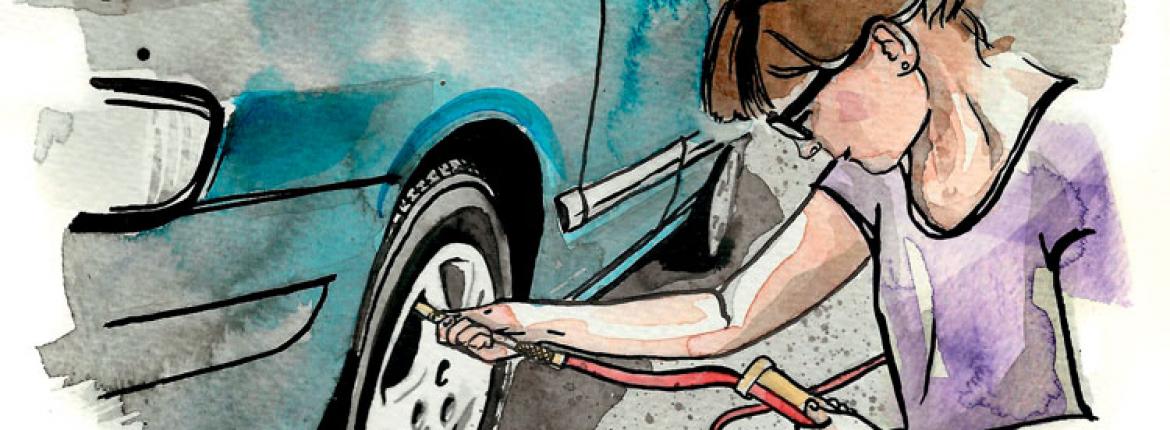Tyre pressure
What: Car tyres have a recommended pressure they should be inflated to.
Why: Incorrect pressure compromises the handling and safety of your car. It’ll also hit you in the pocket. Over- or under-inflated tyres wear rapidly and need to be replaced more often.
How: Check your tyre pressure once a month. Most gas stations have tyre pumps with a pressure gauge. If you’re unsure what to set it to, look for a plate or sticker inside the driver’s door pillar, in the glovebox or in the owner’s handbook. Failing that, you can enter your registration number at energywise.govt.nz/tools/tyre-pressure to obtain the correct tyre pressure for your car. Don’t forget to check your spare.
Tyre tread depth
What: The grooves on your tyres are its tread. By law there must be 1.5mm of tread around the circumference and across three quarters of the width. For safety we recommend replacing tyres before they reach the legal minimum.
Why: A tyre with low tread depth equates to a dangerous car. A bald tyre has little grip making it easy to slide out of control when cornering. You’ll also skid further when braking. In an emergency this could be the difference between stopping safely and having an accident. This goes double in wet weather.
How: Tyres have 1.5mm wear indicator bars moulded into the tread. Once the wear indicators are level with the tyre surface, your tyres are worn to the minimum legal limit.
To check, insert a 20c coin into the tread with the number facing in towards the tyre. If the entire number is visible the tyres only have 2mm of tread left and you should consider replacing them.
Engine oil
What: Oil is the lifeblood that lubricates all the fast moving and rotating parts of your engine.
Why: If the oil level is too low, or the oil is dirty, your engine life can be severely reduced. If the oil’s black, it’s contaminated with tiny carbon or grit particles which act like sandpaper, wearing the moving parts.
How: With the car parked on a flat level surface, remove the dipstick and wipe it clean with a cloth. Re-insert the dipstick and ensure the level is between the high and low level marks. If the level is low, top up with the recommended grade of oil for your car. If the oil is black, it’s time for an oil change. You can buy oil at service stations.
Lights
What: Your headlights, park lights, number plate lights, indicators, brake lights, reverse lights, fog lights, hazard lights, and any other ancillary lights must all function.
Why: The lights aren’t just there for you to see at night or in poor light, they’re also there so other road users can see you and understand what your intentions are, such as turning or braking.
How: This one’s simple. Turn on the lights, walk around your car and make sure they’re all working. You will need someone to help you check the brake lights. Also check all the lenses for discoloration or cracks. Water ingress can damage the electrics or reduce light intensity.
Brake fluid
What: Modern braking systems are filled with a hydraulic fluid that applies pressure to components on each wheel when the brakes are applied.
Why: As the brakes gradually wear, the fluid level drops. Brake fluid is hydroscopic, meaning it retains moisture. It should be changed at the manufacturer’s recommended interval to ensure the moisture doesn’t corrode the internal parts of the system or boil under hard braking, causing complete brake fade.
How: Most hydraulic brake systems have a small plastic reservoir under the bonnet with high and low level marks, between which the level should be maintained. If the level is low, unscrew the cap and top up with the recommended fluid for your car. Paintwork can be damaged by brake fluid so be careful not to spill any.
Windscreen, wipers and washer fluid
What: Wipers and washer fluid ensure good visibility while driving.
Why: It is vital to have a clear view of the road. Dirty windscreens and wiper blades that smear across the screen can compromise vision.
How: While you’re under the bonnet, check the washer fluid. It’s good practice to use a washer additive as this cuts through dirt and grime on the windscreen. Check the washer jets are not clogged and are aiming correctly in the middle of the wiper swept area. If they need adjustment, use a sharp pin in the nozzle and raise or lower as required.
Run your fingers along the edge of the wiper rubbers. If they’re brittle, grooved or damaged, replace them.
Finally, look for chips or cracks on your windscreen. Get any repaired urgently as they can creep, meaning the whole screen will need replacing.
Coolant
What: Coolant in your radiator stops your engine overheating. The fluid also has an additive that prevents freezing in sub-zero temperatures.
Why: Blown head gaskets, cracked cylinder heads and engine seizing are all very expensive results of an overheated engine. If your car uses coolant, or if the coolant looks rusty, get it changed.
How: Many modern engines have a plastic overflow tank with high and low level marks. The ideal level is midway between the marks when the engine is cold. Never remove the radiator cap from a hot engine as the system is under pressure and boiling water can spurt out causing serious burns.
When you remove the radiator cap the fluid level should be near the top. Coolant is either green or pink coloured. The two should never be mixed, but both can be topped up with plain water.
Reported by Andrew Bayliss for our AA Directions Summer 2024 issue








